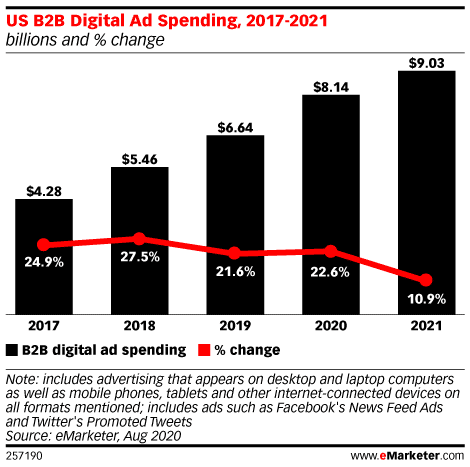![How to Create Your Marketing Budget Plan [Step-by-Step Guide]](https://marketinginsidergroup.com/wp-content/uploads/2023/09/iStock-1040557630.jpg)
How to Create Your Marketing Budget Plan [Step-by-Step Guide]
If you’re like most companies, you realized that annual marketing budget planning doesn’t work anymore.
Annual budgets aren’t flexible enough to keep up with your audience’s dynamic behavior.
Unsurprisingly, 46% of B2Bs say they’re paying closer attention to their marketing’s direct impact on sales post-pandemic as well.
Use this guide to assess your company’s current marketing practices and discover the marketing methods you may want to introduce in this year’s plan.
Quick Takeaways:
- Annual marketing budget planning isn’t ideal anymore. Shoot for monthly or quarterly evaluations to adjust your tactics and strategies.
- Every tactic should serve a specific goal by reaching a specific audience with a specific value proposition. That’s how you squeeze the most results from your budget.
- Keep your strategy actionable and constantly look for real ROI from your marketing efforts. Prioritize tactics based on your budget and needs.
So here are 5 steps to create your marketing budget…
First, if you are looking for a single number to drive content marketing growth, we have your content marketing budget number solved.
My advice is to not overcomplicate things. Planning your budget is simple: What are your goals and what tactics do you need to reach them? How can you work within your provided budget to maximize those results?
Step 1: Analyze and Benchmark Past Marketing Results
Marketing is a balancing act and when you’re trying to increase qualified leads, it should never be a guessing game.
To develop a truly successful marketing budget, you first have to look back at marketing plans from years past.
Use data from Google Analytics, your email marketing service, and your marketing automation system to understand what sources are driving the most leads.
Once you have tangible numbers, you can identify which sources contribute the highest percentage of total revenue via leads and conversions.
After you’ve collected year-over-year analytics data from each marketing channel and their corresponding sales metrics, you should ask yourself two simple but important questions:
- What’s working?
- What’s not working?
Furthermore, ask more specific questions like:
- Which audience segments, accounts, or customers did we target?
- Can we optimize X tactic, or should we shift the budget elsewhere?
- How are our competitors using the same tactics and what do their results look like?
- How does each tactic fit into the buyer’s journey? How is it helping (if at all)?
Unfortunately, each marketing tactic cannot be evaluated in the same way.
Do your best to prioritize marketing tactics based on an unbiased review of their performance each quarter. 2020 showed us that annual budgeting doesn’t work so stay flexible, working on month-to-month or quarter-to-quarter evaluations.
Return on marketing investment (ROMI) can be tough to navigate, but with persistent research, you can optimize the channels that are working in your favor and pull back marketing spend on the tactics that aren’t.
Step 2: Determine Your Marketing Goals
Once you’ve familiarized yourself with the success of your past and current tactical marketing plans, it’s time to determine your 2021 goals for your marketing budget.
After all, you can’t take a road trip if you don’t know where you’re headed.
Your marketing goals should be strategic objectives that are quantifiable, achievable, and specific.
Start from the top by determining your short and long-term business objectives. Some examples include:
- Preventing X clients from churning within the next three months.
- Converting X leads into customers over the next month.
- Turning X accounts into leads within the next year.
With this information, you can understand the amount of revenue you will need to achieve those goals, which tactics you’ll need to reach them, and how.
Here’s where the fun starts.
Armed with these numbers and your data from step one, you can begin to break down these goals even further, setting success measurements for each marketing channel and tactic.
For tactical goals, be specific in terms of budget and results. How much are you willing to spend on this tactic? How many clicks or new leads do you expect this tactic to generate?
Here’s an example:
- Channel: Digital marketing
- Platform: Google AdWords
- Tactic: PPC campaign
- Spend: $3,000/month
- Goal: 500 clicks, 30 conversions
It’s important to establish objectives, but there should be some element of flexibility. Many factors that will impact progress toward your goals are constantly in flux, such as the cost associated with certain keywords and ad groups on Google AdWords.
Keep in mind that circumstances may change throughout the year and budgets may have to be adjusted. If your current structure does not allow for budgetary changes, alter your goals and expectations accordingly.
Step 3: Decide Where to Devote Your Marketing Budget
You have multiple marketing channels to choose from when creating your 2021 plan, but most marketers will recommend an integrated approach.
If your budget is tight, it may be in your best interest to focus investments on one or two channels. A few channels that every modern marketer should consider include:
Website Development
Investing in development can go a long way.
90% of visitors will immediately leave a site with low-quality design that doesn’t prioritize user experience. Another 93% leave sites straight away if they’re not designed right for the device they’re using. Plus, Google uses mobile-first indexing to rank pages in search.
Either way, web design is 100% worth the investment every time.
Display Advertising & Pay-Per-Click (PPC)
As we enter the second year of pandemic restrictions, B2B ad spend is expected to rise nearly 11% in 2021.

Display advertising is an economical online advertising method, offering the opportunity to display graphic banner ads on website categories of your choosing.
PPC, while more costly, is extremely customizable. Advertisers can specify bids, ad copy, display time of day, location targeting, and more.
Email Marketing
A standard among most companies, features like personalization and automation make email a staple for most marketing budgets. Experiment with email workflows to capture leads and incorporate responsive elements to heighten engagement metrics. Personalize account-based email campaigns and use email marketing to nurture leads with relevant content.
Social Media Advertising
For marketers who have established a strong social media presence for their company, social media advertising is an excellent tactic. LinkedIn is the most beneficial for B2B marketers thanks to its extensive retargeting features, while Facebook suits B2C marketers.
Search Engine Optimization (SEO)
67% of buyers say an internet search is the first place they go to find content. Regardless, everything you publish must be 100% optimized for searches and mobile.
Content Creation
59% of B2B companies say they’re prioritizing content creation more than they have in the past.
The key is to create content that genuinely helps your buyers understand your industry like product comparisons, tutorials, infographics, and videos. Study the competition and do better.
Another 55% say they’re focusing more on thought leadership content.
Make sure a portion of your marketing budget goes to this valuable strategy. Thought leadership positions your company as an ideological go-to when things get tough or questions arise. It also ensures that your content marketing is authoritative and has purpose.
Thought leadership isn’t adding nuance or edginess for its own sake. It’s about positioning yourself as an authority in your niche.
You should strive to answer questions in your niche better and more thoroughly than anyone else, always with plenty of context, adding some nuance only when necessary.
PR & Social Media
The key is to think of your content as a PR tool and social media as the promotional channel.
Develop content for various accounts and audience segments at different stages of the funnel – including existing customers. This will be the public “face” of your brand.
LinkedIn and Facebook both offer extensive retargeting tools so you can reach users who already visited specific pages on your website. Retarget users with the next piece of content along the funnel to gently nurture them.
Likewise, make sure you’re focusing on the “social” aspect of social media.
Don’t broadcast. Initiate conversations that don’t involve selling your products or promoting your company. Curate content from other sources. Share useful studies and information with your followers.
Show your audience that you care about their experience on social media and overall wellbeing.

Traditional Marketing Channels
Traditional marketing methods have been a staple in the industry for decades and most are still in use. Direct mail, event marketing, television spots, and print advertising are still a core focus for many marketers.
But be wary of opting for traditional methods unless you can prove that the tactics will result in strong leads. If not, they may not be worth the significant investment.
Modern digital advertising offers more transparent metrics and tracking capabilities. Plus, traditional marketing channels aren’t targeted like digital options.
In most cases, you’re better off saving your traditional marketing budget and using it for sponsoring relevant events in your industry.
Step 4: Prioritize Your Needs
Here’s the hard part. Marketing on every platform is ideal, but for small to medium-sized businesses (SMBs), this may not be realistic.
To prioritize your marketing needs, start with the costliest endeavors. Choose the tactic that is the most effective at driving leads and go from there.
Once you’ve incorporated the tactics that require the most spend, you can balance the rest of your budget with more cost-effective tactics.
Most B2B and B2C marketers find that working with an agency helps determine the best marketing mix. For most of our clients, the marketing channel priorities that garner the most online success include:
- PPC campaigns
- Content marketing
- SEO
- Thought leadership
Step 5: Develop a Holistic Strategy for Your Marketing Budget to Succeed
Everything you publish and every marketing tactic should serve a specific goal. Everything must rope back into your broader marketing strategy.
That’s how you keep your marketing budget focused and working in your interests.
Make sure every piece of content, advertisement, and social media post:
- Targets one audience segment
- Includes relevant and useful information
- Offers something they can’t find anywhere else
- Serves a specific goal
- Answers or solves a specific question, problem, or pain point
Evaluate Your Marketing Budget, Results, and Adapt
Ultimately, there’s no magic formula. Your marketing budget should be a mix of different methods, based on the resources you’re working with and the audience you’re trying to reach.
Here’s a cheat sheet to make sure you’re working within your means to deliver results and ROI:
- Analyze your past results and set benchmarks.
- Set your goals over a specific time frame – make sure they’re attainable, specific, and challenging.
- Map all your available strategies and tactics: content, thought leadership, web design, social media, etc.
- Prioritize where to devote your marketing budget.
- Develop a holistic strategy for your budget, tactics, and goals.
At the end of each goal’s time frame, evaluate your tactic’s performance and look for areas to improve. In some cases, this may mean switching that portion of your budget to a new tactic entirely. In others, it may mean adjusting your target audience, value proposition, or content messaging.
This guide should serve as a starting point for your 2021 marketing planning and help you bring increased exposure to your business in the new year.
Ready to reach your content goals in 2021? Our custom Content Builder Services help you maximize your budget while you enjoy a hands-off approach.






